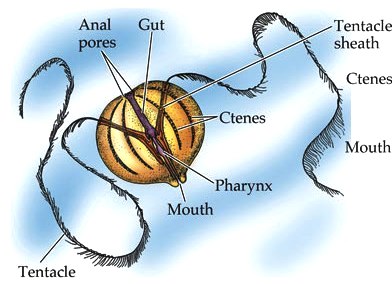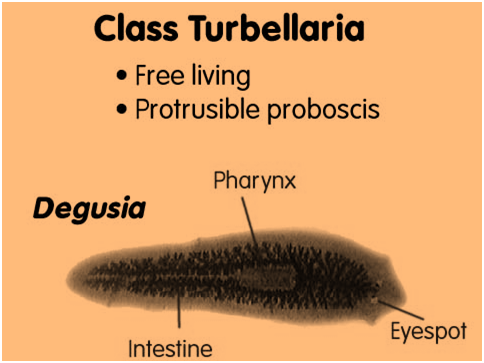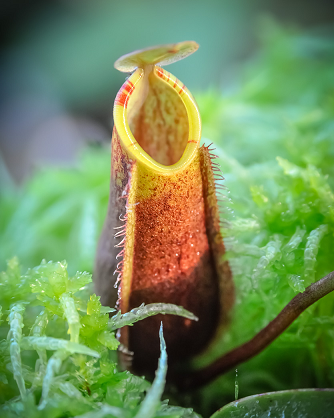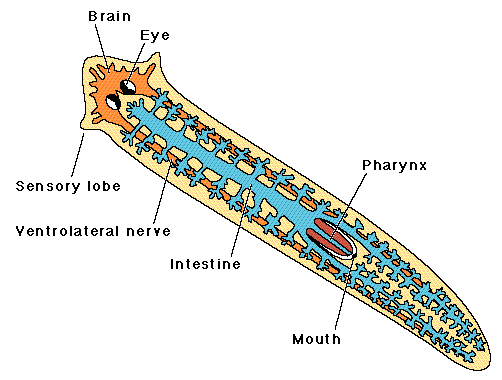Ctenophora, Platyhelminthes & Aschelminthes (Nematoda)
Table of Content |
|
|
Phylum-Ctenophora (Coelenterata)

 - Ctenophora is a small phylum.
- Ctenophora is a small phylum.
- It contains only about 80 species.
- It includes a set of marine animals commonly called comb jellies or sea walnuts.
- These animals exhibit the characters of Coelenterata and platyhelminthes.
- Formerly this phylum was placed under Coelenterata. Hatschek (1889) placed it under a separate phylum called Ctenophora.
- The important Ctenophore animals are Pleurobachia, Coeloplana, Ctenoplana, Velamen, hemiphora, Beroe, etc.
Salient Features
Phylum Ctenophora shows the following salient features
(1) All the ctenophores are marine.
(2) They are solitary and pelagic.
(3) They are transparent.
(4) They have tissue-grade of organization.
(5) They have biradial symmetry.
(6) They are acoelomate animals.
(7) They are unsegmented.
(8) They body-wall is diploblastic.
(9) The mesogloea contains cells.
(10) Nematocysts are absent.
(11) Special adhesive cells called colloblasts are present in all ctenophores.
(12) The gastrovascular system is well developed.
(13) Two anal openings are present.
(14) Skeletal system is absent.
(15) Excretion and respiration are carried out by diffusion.
(16) The nervous system is in the form of nerve net.
(17) An aboral sense organ in present in the form of statocyst.
(18) Cilia are used for locomation.
(19) They are hermaphrodites.
(20) Development is indirect. It includes a cydippid larva.
Classification of Ctenophora
(1) The body is simple, rounded or oval or ribbon-like.
(2) Two long aboral tentacles are present.
(3) Mouth is narrow and pharynx is small.
Order 1. Cydippida
(1) Body is oval or rounded
(2) Two long branched tentacles are present and they can be retracted into sheaths
(3) Branches of gastro–vascular system are terminating blindly
(4) Examples : Hormiphora, Pleurobrachila, etc.,
Order 2. Lobata
(1) Body is laterally compressed
(2) Two large oral lobes or lappets and four pointed processes or auricles are present
(3) Tentacles are many, non–retractile without sheaths.
(4) Stomodaeal and meridional vessels unite with one another
(5) Examples : Deiopea, Bolinopsis, etc.,
Order 3. Cestida
(1) Body is laterally compressed and ribbon-like
(2) Two main tentacles and may lateral tentacles are present
(3) Four rows of rudimentary comb plates are present
(4) Meridonal and stomodaeal vessels anastomose
(5) Examples : Cestum, Velamen, etc.,
Order 4. Platyctenea
(1) Body is worm-like and compressed in oral-aboral axis
(2) Tentacles with sheaths are present
(3) Comb rows or swimming plates are present only in larva
(4) Meridional canals are absent, but there is a system of branching peripheral system
Class 2. Nuda
(1) Body is large thimble-shaped or conical
(2) Tentacles are absent
(3) Mouth is wide and pharynx is large
(4) The meridional vessels are produced into a complex system of anastomosing branches
(5) Example : Beroe


Question 1: The phylum of comb jelly is
(a) Mollusca
(b) Echinodermata
(c) Coelenterata
(d) Ctenophora
Question 2: Why does the Ctenophora is a minor phylum
(a) It includes small sized animals
(b) It includes only few genera
(c) It does not include animals of economic importance
(d) It was included earlier in cnidaria
Question 3: Which of the following animals has a tetramorphic colony?
(a) Obelia
(b) Physalia
(c) Porpita
(d) Velella
Question 4: Which of the following animals is without sexual medusae?
(a) Halistemma
(b) Hydra
(c) Millepora
(d) Velella
Question 5: Which coelenterate is not polymorphic?
(a) Porpita
(b) Vellela
(c) Adamsia
(d) Physalia
|
Q.1 |
Q.2 |
Q.3 |
Q.4 |
`Q.5 |
|
d |
b |
b |
b |
c |
Phylum-Platyhelminthes
 - Bilateral and protostominal “organ grade” eumetazoans without a body cavity (acoelomates).
- Bilateral and protostominal “organ grade” eumetazoans without a body cavity (acoelomates).
- “Platyhelminthes” means flatworms (Gr., platys = flat; helmins = worms).
- Their body is dorsoventrally flattened.
Brief History
- Aristotle mentioned tapeworms, but scientific studies of flatworms began only in the 18th century.
- It was Gegenbaur (1859) who placed these in a separate group and suggested the present name of the phylum.
Salient Features
(1) They are dorso ventrally flattened like a leaf
(2) They show organ grade of organization
(3) They are acoelomate animals. The cavity in platyhelminthes is filled with mesenchyme or parenchyma
(4) They are triploblastic animals. The cells of the body wall are arranged in three layers.They are the ectoderm, the mesoderm and the endoderm
(5) They are bilaterally symmetrical animals. The body of the animal can be divided into two equal similar halves through only one plane. Animals with this symmetry have definite polarity of anterior and posterior ends.
(6) Some members have segmented body. The segmentation in platyhelminthes is called pseudometamerism
(7) Many of the parenchyma cells give rise to muscle fibres.The muscle fibres are arranged in circular, longitudinal and vertical layers.
(8) The digestive system is completely absent from Cestoda and Acoela. The alimentary canal is branched in Turbellarians. The anus is absent from them.
(9) The respiratory organs are absent. In parasites respiration is anaerobic
(10) There is no circulatory system
(11) The excretory system is formed of protonephridia (flame cells)
(12) The nervous system is well developed. It is formed of longitudinal nerve cords with ganglia. A pair of anterior ganglia forms the brain. The longitudinal nerve cords are connected together by transverse connectives.
(13) They are hermaphrodites, i.e., both male and female reproductive organs are present in the same animal
(14) Fertilization is internal in them. Self or cross fertilization takes place in them.
(15) Their development is direct or indirect. Endoparasites show usually indirect development with many larval stages. Their life cycle is completed in one or two hosts.
(16) They are free-living or parasitic. In parasitic worms adhesive organs like hooks, spines, suckers and adhesive secretions are present.
Classification of Platyhelminthes
Class 1. Turbellaria
(1) Most of the turbellarians are free living but some of them are ecotocommensal or parasitic
(2) The body epidermis is either cellular or syncytial and covered with cilia. Epidermis contains rhabdites
(4) Digestive system is present except in a few
(5) Suckers are absent
(6) Life cycle is simple
(7) Example : Dugesia, Notoplana, Bipalium
Class (2) – Trematoda
(1) Ecto or endoparasites of vertebrates; commonly called flukes.
(2) Body mostly oval, unsegmented.
(3) Body wall without cilia, but covered by a thick, resistant, syncytial tegument.
(4) Suckers, and often hooks and spines, present for attachment to host tissues.
(5) Sense organs usually absent in adults.
(6) Digestive system well developed with terminal mouth, but no anus.
(7) Mostly hermaphrodite. Life cycle simple or complicated.
(8) Examples : Polystomum, Fasciola, Schistosoma (blood fluke of man and other mammals).
Class (3) – Cestoda
(1) All endoparasites. Mostly in alimentary canal of vertebrates; commonly called tapeworms.
(2) Body long and slender, tape-like, usually divided into small segments (= proglottids).
(3) Body wall non-ciliated, with a thick tegument.
(4) Anterior end with suckers and other attachment organs.
(5) No mouth; digestive system absent ; digested liquid food is absorbed from host tissues by diffusion through body wall.
(6) Sense organs absent.
(7) Each proglottid contains one or two complete sets of hermaphrodite (bisexual) reproductive organs.
(8) Life-cycle usually complicated with alternation of hosts. Embryo hooked.
(9) Examples : Taenia, Echinococcus, Hymenolepis.


Question 1: Solenocytes and nephridia are respectively found in
(a) Platyhelminths and Annelids
(b) Annelids and Nematoda
(c) Cnidaria and Mollusca
(d) Mollusca and Echinodermata
Question 2: Which of the following is a free living flat worm
(a) Planaria
(b) Taenia
(c) Fasciola
(d) Pheretima
Question 3: The free living platyhelminthes are
(a) Turbellaria
(b) Cestoda
(c) Trematoda
(d) Trematoda and cestoda
Question 4: Miracidium larva occurs in the life history of
(a) Round worm
(b) Liver fluke
(c) Earthworm
(d) Tapeworm
Question 5: Cestodes are distinguished from other flatworms by the absence of
(a) Nervous System
(b) Digestive system
(c) Excretory system
(d) Reproductive system
|
Q.1 |
Q.2 |
Q.3 |
Q.4 |
Q.5 |
|
a |
a |
b |
b |
b |
Phylum-Nematoda (Aschelminthes)
-
Earlier round worms or thread worm were classified as Aschelminthes by Grobben.

-
Gagenbour established the Phylum Nemathelminthes.
-
Phylum includes round worms.
-
Nematods are found everywhere in fresh water, sea water, soil humus-rich soil.
-
Many as a parasite and cause health problems.
-
Animal of this phylum are Cylindrical, tapering at both end without segmentation.
-
Symmetry- Bilateral
-
Germ layer - Triploblastic
-
Level of organisation - Organ-system level and have tube within tube plan.
-
Anterior end does not show distinct head.
-
No appendages
-
Body wall consist of :
(1) Cuticle - Firm, non living, resistant to digestive enzymes of host.
(2) Epidermis - Without cilia. Syncytial i.e., a continuous layer of cytoplasm having scattered nuclei.
(3) Muscle layer: Longitudinal fibre divided into four quadrants.
-
Body cavity is there between body wall and digestive tract which is not lined by mesothelium i.e. Pseudocoel (developed from blastocoel) and contain Pseudocoelomic fluid.
-
Skeleton is not mineralized. High fluid pressure in the pseudocoelom maintains body shape. It is called Hydroskeleton. Digestive tract is complete and differentiated into mouth, pharynx, intestine & anus.
-
Mouth is surrounded by 3 - lips having sensory papillae and amphids.
-
Pharynx is muscular. It is used to suck of food. Intestine is non muscular.
-
Respiration is through body surface by diffusion.
-
Circulatory system is undeveloped
-
Nervous system comprises of circum pharyngeal ring (Brain). Sense organs like Papillae (Tangoreceptors), Amphids (chemoreceptor) are present on lip.
-
Paired unicellular Phasmids (chemoreceptor) are found near hind end of body.
-
Excretory system is H-shape consists of gland cells or intracellular canal or Protonephridia - (Renette cell).
-
Excretory matter is ammonia.
-
Reproduction system is developed and sexes are generally separate.
-
Sexual dimorphism is present.
-
Male is smaller than female and curved from its caudal end.
-
Male has Penial spiculas for copulation. Genital tract joins digestive track to form cloaca.
-
Genital track open independently. Female lays numerous eggs with Chitinous shell.
-
Fertilization is internal and development is mostly direct.
-
Cleavage is Holoblastic spiral and determinate type. Number of cells are fixed from larva to adult development known as Eutely.
-
Nematoda has been classified into two classes on the basis of specialised sense organ, caudal receptor & excretory system.
Class Phasmidia
Examples :
-
Ascaris - Intestinal round worm (in small intestine) larva - Rhabditiform/Rhabditoid
-
Enterobius - Pin worm or seat worm (in large intestine)
-
Ancylostoma - Hookworm (in small instestine)
-
Wuchereria - Filarial worm (in Lymph vessels /gland) by female culex mosquito.
-
Loa-loa - Eye worm (African eye worm)
-
Rhabditis - Free living.
-
Trichinella - (First in intestine then in stripped muscle)
-
Dracunculus - Guinea worm (madina worm) or fieryserpent (Digenetic - Cyclops as intermediate (Oldest discovered Nematode)
Class Aphasmidia
Example : Desmoscolex
Unique Features
-
Syncytial epidermis.
-
Body wall musculature is of longitudinal fibres only.
-
Pseudocoel, a body cavity without a lining of mesodermal coelomic epithehum.
-
Complete digestive tract
-
Fluid-filled body cavity
-
Separate sexes.


Question 1: Pin worm is called as
(a) Schistosoma haematobium
(b) Wuchereria bancrofti
(c) Ancylostoma duodenale
(d) Anterobius vermicularis
Question 2: Female Ascaris lumbricoides is identified on the basis of
(a) Straight posterior end
(b) A common cloacal aperture
(c) Presence of two spicules at posterior end
(d) Presence of pre and post anal papillae
Question 3: Pineal setae in male Ascaris are found in
(a) Cloaca
(b) Rectum
(c) Anus
(d) Mouth
Question 4: One of the following characteristics is not correct for nematoda
(a) Elongated cylindrical body
(b) Fixed number of cells in the body
(c) Hermaphroditism
(d) Pseudocoelomate
Question 5: Female Ascaris differs from the male in
(a) Having pineal setae
(b) Curvature of tail
(c) Body length


|
Q.1 |
Q.2 |
Q.3 |
Q.4 |
Q.5 |
|
d |
a |
a |
c |
c |
Related Resources
-
Click here to refer the Useful Books of Biology for NEET (AIPMT)
-
Click here for study material on Animal Kingdom
To read more, Buy study materials of Animal Kingdom comprising study notes, revision notes, video lectures, previous year solved questions etc. Also browse for more study materials on Biology here.
View courses by askIITians


Design classes One-on-One in your own way with Top IITians/Medical Professionals
Click Here Know More

Complete Self Study Package designed by Industry Leading Experts
Click Here Know More

Live 1-1 coding classes to unleash the Creator in your Child
Click Here Know More

a Complete All-in-One Study package Fully Loaded inside a Tablet!
Click Here Know MoreAsk a Doubt
Get your questions answered by the expert for free






